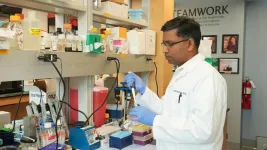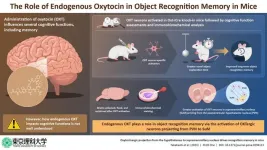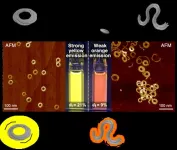Importantly, this natural oil is known for its health benefits and medicinal applications from antibacterial to anticancer because of its phytochemical constituents. In addition to containing esters, free acids, aldehydes, ketones and santenone, sandalwood oil primarily (90 percent or more) constitutes santalol – equal amounts of two compounds, alpha and beta-santalol.
Now, researchers from Florida Atlantic University’s Schmidt College of Medicine and collaborators are the first to demonstrate in vivo the chemo-preventive properties of alpha-santalol against prostate cancer development using a transgenic mouse model.
Results of the study, published in the journal Phytomedicine Plus, showed that administration of alpha-santalol decreased the incidence of prostate tumors by decreasing cell proliferation and inducing apoptosis, without causing weight loss or any noticeable side effects. Apoptosis, or programmed cell death, is a method the body uses to get rid of unneeded or abnormal cells such as cancer cells.
Findings revealed that the area occupied by normal tissue in alpha-santalol-treated mice was 53 percent compared to 12 percent in control mice. This suggests that administering alpha-santalol protected the normal tissue and delayed progression from prostatic intraepithelial neoplasia, a precancerous condition, to poorly differentiated carcinoma, a high-grade form of cancer where cancer cells and tissue look very abnormal. These results are significant because mortality in prostate cancer patients is mainly attributable to advanced stages of the disease.
In prior studies, the researchers demonstrated the efficacy of alpha-santalol in suppressing growth and inducing apoptotic cell death in cultured human prostate cancer cells. Based on these observations, they selected a genetically engineered mouse model that resembles many features similar to human prostate cancer, eliciting different lesion grades and cancer progression.
“Although our cellular studies provided important mechanistic insights, relevant in vivo models are vital for developing novel chemo-preventive agents for clinical use and to determine if alpha-santalol offers protection against prostate cancer development,” said Ajay Bommareddy, Ph.D., senior author and an associate professor of pharmacology in the Department of Biomedical Science, FAU Schmidt College of Medicine. “Prior to this new study, alpha-santalol’s in vivo efficacy against prostate cancer development had not yet been established.”
Additional findings of the current study showed alpha-santalol reduced the incidence of visible prostate tumors compared to control-treated mice. Only 11 percent in the treated group developed prostate tumors whereas more than half in the control group developed the tumors. The differences in urogenital and prostate weights were statistically significantly different in alpha-santalol-treated mice compared with controls. The average wet weight of urogenital tract in alpha-santalol treated mice was about 74.28 percent lower compared with control mice. Similarly, the average wet weight of the prostate gland was lower by 52.9 percent compared with control mice.
Prostate cancer is the second leading cause of cancer death in men in the United States. An estimated 288,300 new cases were diagnosed in American men last year with about 34,700 estimated deaths.
Current treatment methods for prostate cancer include androgen ablation, chemotherapy, radiotherapy and radical prostatectomy, but are ineffective against advanced prostate cancers. Early detection and local therapy have resulted in improved outcomes but has been challenging with the management of advanced stages.
“Identifying agents that have the ability to selectively target cancerous cells and delay onset and progression of prostate cancer is greatly needed,” said Bommareddy. “Additional studies are essential to systemically explore the feasibility of alpha-santalol as a promising chemo-preventive and anti-tumor agent against human prostate cancer development and to elucidate the mechanisms surrounding the role of pro-apoptotic and antiapoptotic proteins.”
Study co-authors are John Oberlin Jr., PharmD; Kaitlyn Blankenhorn, PharmD; Sarah Hughes, PharmD; Erica Mabry, PharmD; Aaron Knopp, PharmD; Adam L. VanWert, PharmD, Ph.D., all with the Wilkes University Nesbitt School of Pharmacy; Chandradhar Dwivedi, Ph.D., South Dakota State University; Isaiah Pinkerton, a graduate of Wilkes University; and Linda Gutierrez, M.D., Wilkes University.
- FAU -
About the Charles E. Schmidt College of Medicine:
FAU’s Charles E. Schmidt College of Medicine is one of approximately 156 accredited medical schools in the U.S. The college was launched in 2010, when the Florida Board of Governors made a landmark decision authorizing FAU to award the M.D. degree. After receiving approval from the Florida legislature and the governor, it became the 134th allopathic medical school in North America. With more than 70 full and part-time faculty and more than 1,300 affiliate faculty, the college matriculates 64 medical students each year and has been nationally recognized for its innovative curriculum. To further FAU’s commitment to increase much needed medical residency positions in Palm Beach County and to ensure that the region will continue to have an adequate and well-trained physician workforce, the FAU Charles E. Schmidt College of Medicine Consortium for Graduate Medical Education (GME) was formed in fall 2011 with five leading hospitals in Palm Beach County. The Consortium currently has five Accreditation Council for Graduate Medical Education (ACGME) accredited residencies including internal medicine, surgery, emergency medicine, psychiatry, and neurology.
About Florida Atlantic University:
Florida Atlantic University, established in 1961, officially opened its doors in 1964 as the fifth public university in Florida. Today, the University serves more than 30,000 undergraduate and graduate students across six campuses located along the southeast Florida coast. In recent years, the University has doubled its research expenditures and outpaced its peers in student achievement rates. Through the coexistence of access and excellence, FAU embodies an innovative model where traditional achievement gaps vanish. FAU is designated a Hispanic-serving institution, ranked as a top public university by U.S. News & World Report and a High Research Activity institution by the Carnegie Foundation for the Advancement of Teaching. For more information, visit www.fau.edu.
END




